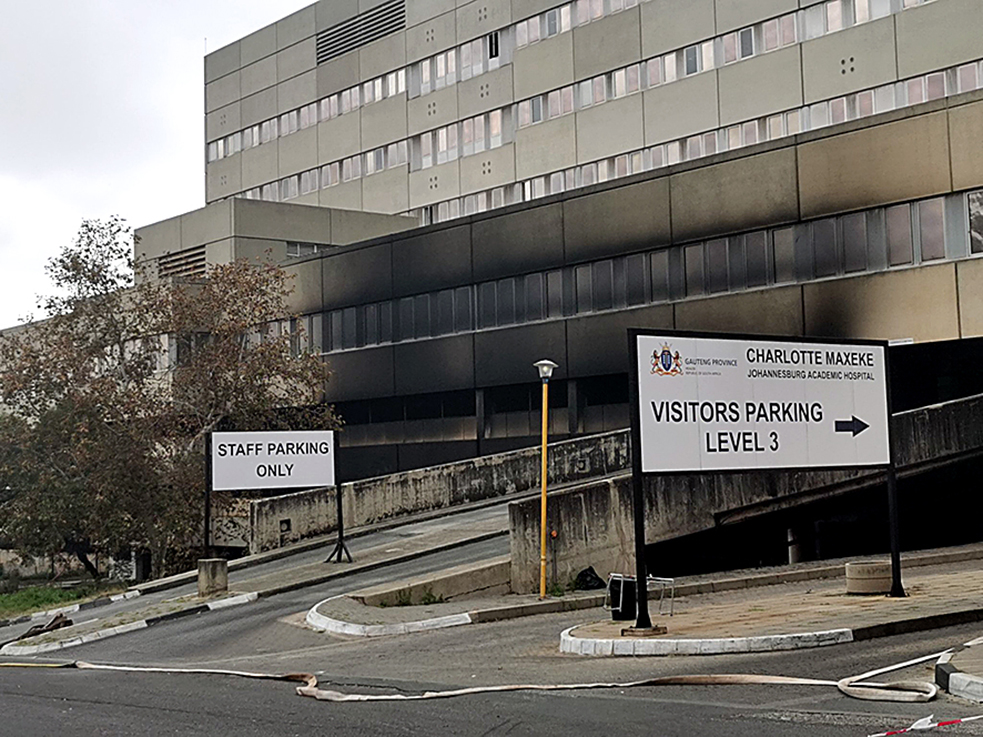
Banner

Joburg’s Charlotte Maxeke Hospital open, but not out of casualty
It has been a long and painful recovery for the Charlotte Maxeke Johannesburg Academic Hospital (CMJAH), ravaged by fire more than a year ago. With the road to a full comeback seemingly endless, Jewish healthcare workers just want to get on with the business of the day – saving lives.
“We’re used to being overworked,” said one anonymous doctor shunted to another overburdened public hospital after the fire in April last year.
This week, the casualty unit at CMJAH was finally declared open, but the lifeblood of the hospital – its critical trauma and emergency unit – remains closed to walk-in patients.
“At the moment, there will be no walk-in patients into the accident and emergency unit. For now, it’s only open for the arranged transfer of patients who have been seen in other centres. This is a way to relieve pressure on other facilities,” Health Minister Dr Joe Phaahla said during a high-level walk about at the flagship hospital on Monday, 9 May.
He said the trauma and emergency unit would be reopened in phases, with completion of the rebuild scheduled for November 2023.
The devastating fire still remains etched in the hearts and minds of those healthcare workers who were there on the night of 16 April 2021 when all hell broke loose.
“It was a night I’ll never forget,” said one doctor who spent 12 frantic hours trying to evacuate patients from smoke-filled wards.
“It was like a horror movie,” she told the SA Jewish Report at the time. It was nothing short of a miraculous, logistical feat as more than 800 patients were moved to other stretched medical facilities across the province, placing them under an enormous burden.
In the hazy aftermath, clinicians, from interns to heads of departments, nurses, and every healthcare worker from the top down have scrambled to make things work. Only just.
Delays, obfuscations, and ever-moving deadlines led to desperate pleas from doctors to expedite the repair of the hospital. Angry cries of incompetence were levelled at the Gauteng Health Department (GHD) and the Gauteng department of infrastructure development, with the mammoth task of fixing the facility finally involving the National Department of Health (DOH).
The GHD is notorious for corruption scandals and poor service delivery, as seen in the personal protective equipment scandal which came to light during the COVID-19 epidemic. Infrastructural headaches and a serious lack of parking as well as infuriating vandalism, theft, and security concerns in general continued to stall progress.
The re-opening of casualty was set back when the Central Processor Unit for the CT scanner was stolen, cables were cut, and copper pipes stolen. “This occurred in spite of R40 million a year spent on a security company and CCTV cameras to guard the hospital,” said Democratic Alliance Gauteng shadow MEC for health, Jack Bloom.
All these delays caused huge distress to staff and patients at other hospitals like Chris Hani Baragwanath Academic Hospital and Helen Joseph Hospital, which were bursting with extra patients.
Bloom bemoaned the fact that Helen Joseph casualty was “overwhelmed with patients who are squeezed into corridors and sit in chairs for long periods before being admitted”.
This week, he expressed disappointment that the accident and emergency unit at CMJAH wasn’t fully reopened mostly because the CT scanner hadn’t yet been repaired.
“This highlights the need for proper security. It appears that there are criminal syndicates that could still sabotage the re-opening of other hospital departments,” said Bloom.
“It’s vital that cast-iron guarantees are given that the deadlines are met for obstetrics and gynaecology to open in March next year, paediatrics in July, surgery in October, and internal medicine in November 2023.
“The public and private sector need to work efficiently together to ensure that there aren’t further delays in getting the hospital departments up and running. If this doesn’t happen, hundreds of patients will continue to suffer at hospitals like Helen Joseph, which cannot cope with the flood of CMJAH patients,” Bloom said.
One Jewish doctor, who wishes to remain anonymous, left CMJAH at the end of last year when her contract expired and wasn’t renewed.
“I’m now one of the many unemployed healthcare workers struggling to find a permanent post,” she said.
Media reports haven’t depicted the situation at CMJAH accurately, she said, with the wrong impression created that the whole hospital had been closed since the fire.
“The hospital has been partially open for a while, only casualty was closed, and the hospital was closed to after-hours walk-ins. I don’t think the fire did much to work uncertainty, our jobs are quite sporadic at the best of times, and moving around comes with the job. However, there’s no question that the fire put more pressure on the other hospitals in Johannesburg. Sadly, it further delayed follow ups, scans, and procedures, some of which are essentially lifesaving in an already excessively overburdened system.
“Another big issue is that many patients were lost in the chaos. Many who missed appointments because of the previous closure have now been lost in the system, cannot be contacted to return, and probably will deteriorate without being seen by a specialist and return only when their conditions reach an unbearable stage.
“The bigger story here is that even with one hospital ‘closed’ and the others chronically short-staffed and overburdened, the DOH has cut the number of posts, which has further decreased the doctor-patient ratio around the country. There are many doctors, myself included, who are sitting at home begging to work, while our colleagues are trying desperately to cover the shortfall and are ultimately drowning. The ones who are suffering the most are the patients. Our healthcare system has passed breaking point, we have reached the point where our current resources can no longer meet the needs of our population, especially after the havoc COVID-19 caused in terms of chronic follow ups, and the DOH seems only to be cutting resources further. Even with the CMJAH casualty fully operational, the healthcare system is in big trouble.”
Meanwhile, Phaahla said the hospital was 75% to 80% fully operational, with about 800 admitted patients, and was serving about 50 000 outpatients monthly.
Concerns remain that even as units and departments come back into full operation, there’s little talk about how to clear patient backlogs all adding to sinking staff morale at Joburg’s key public sector hospital.










